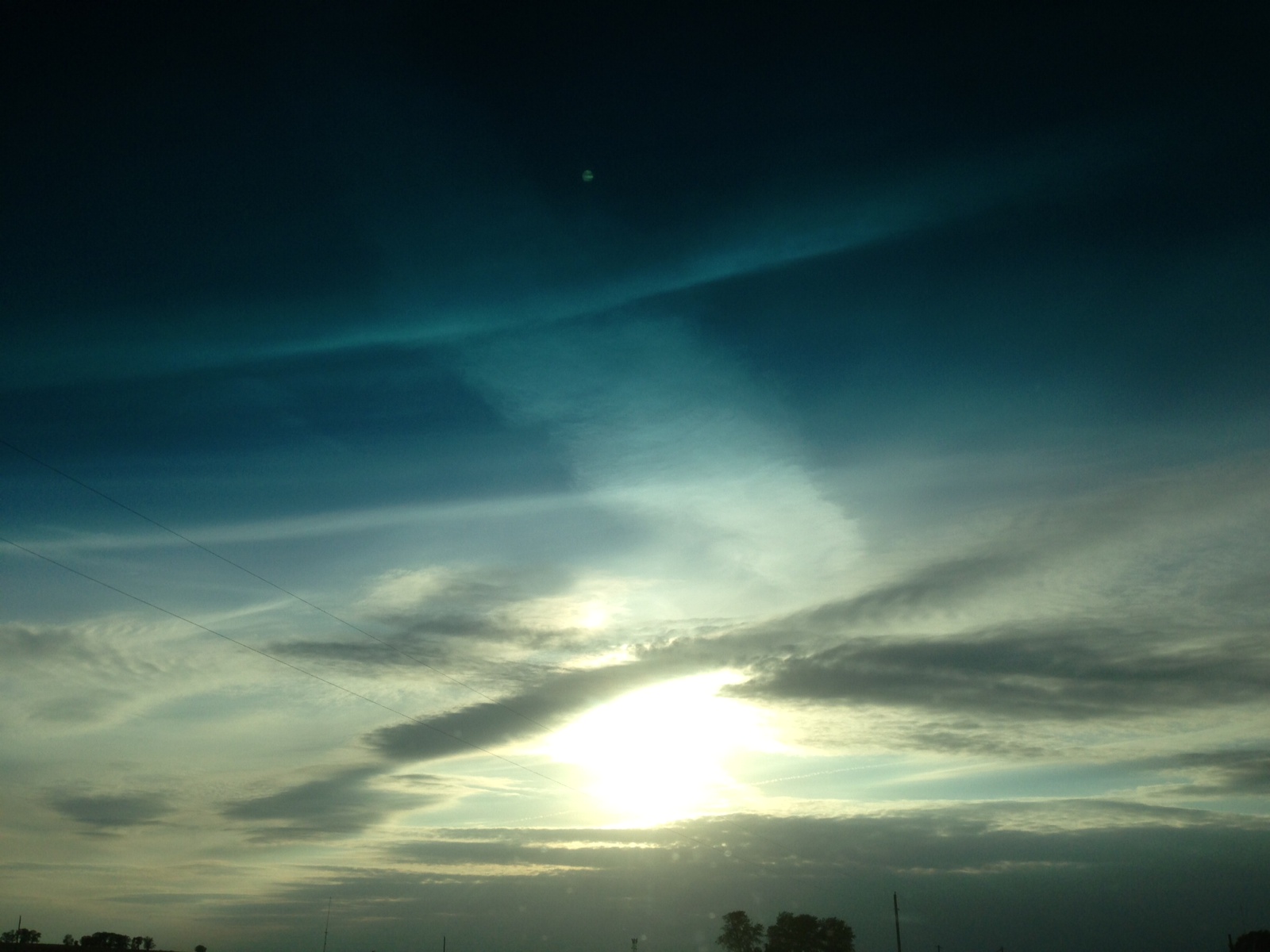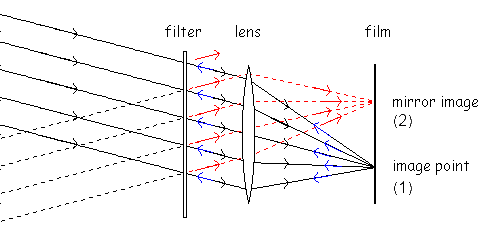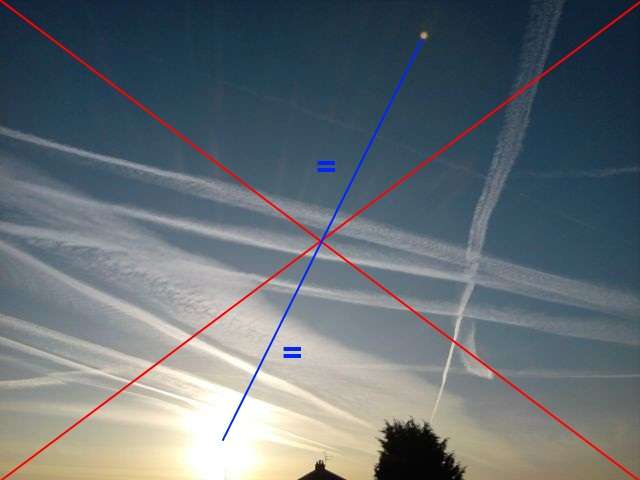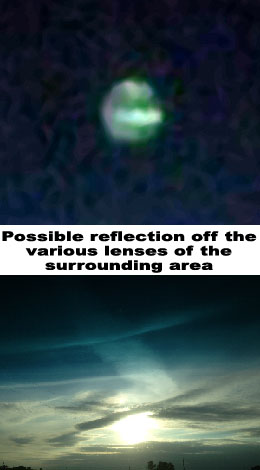It looks like you're using an Ad Blocker.
Please white-list or disable AboveTopSecret.com in your ad-blocking tool.
Thank you.
Some features of ATS will be disabled while you continue to use an ad-blocker.
2
share:
And by UFO, I mean Unidentified Flying Object. Not an alien spacecraft with little green men in it.
Alright so I have a good friend and his name is Matt, he works as a landscaper and his foreman is very heavily into conspiracy theories and I marched with them during this summer in Peoria, Illinois if any of you are familiar with the area. Anyway, my friend Matt often shows me pictures that his foreman has sent him of what appear to be chem-trails (this isn't the topic of the thread, so let's not debate this, please). Well today my friend Matt showed me a picture, and I couldn't help but notice a little dot towards the upper portion of the picture. I zoomed in on it (iPhone 4) and there is definitely something there. I've never seen a UFO, I don't believe I have been abducted, but considering that I can't even comprehend the size of our own solar system, let alone the entire known universe, I don't think it's too far out there to say that there is intelligent life out there somewhere.
I honestly don't know what it is I'm looking at, I was pretty shocked when I first noticed it on my phone. Now that I'm seeing it blown up on my computer screen, I'm pretty shocked again. So what's your opinion on this?

EDIT: I apologize if the pictures formatting is wrong or if the picture is too big, this is my first attempt at embedding a picture and I am certainly not skilled with computers, but hey I tried!
Alright so I have a good friend and his name is Matt, he works as a landscaper and his foreman is very heavily into conspiracy theories and I marched with them during this summer in Peoria, Illinois if any of you are familiar with the area. Anyway, my friend Matt often shows me pictures that his foreman has sent him of what appear to be chem-trails (this isn't the topic of the thread, so let's not debate this, please). Well today my friend Matt showed me a picture, and I couldn't help but notice a little dot towards the upper portion of the picture. I zoomed in on it (iPhone 4) and there is definitely something there. I've never seen a UFO, I don't believe I have been abducted, but considering that I can't even comprehend the size of our own solar system, let alone the entire known universe, I don't think it's too far out there to say that there is intelligent life out there somewhere.
I honestly don't know what it is I'm looking at, I was pretty shocked when I first noticed it on my phone. Now that I'm seeing it blown up on my computer screen, I'm pretty shocked again. So what's your opinion on this?

EDIT: I apologize if the pictures formatting is wrong or if the picture is too big, this is my first attempt at embedding a picture and I am certainly not skilled with computers, but hey I tried!
edit on 10-10-2012 by RomeByFire because: (no reason given)
edit on 10-10-2012 by
RomeByFire because: (no reason given)
It looks like a water spot on the lens or window. There are more toward the horizon.
I do not really think it looks like the water droplets in the bottom.
This one has some kind of edge going along in the middle.
Hmm, though that brighter edge could be a reflection from the sun.
This one has some kind of edge going along in the middle.
Hmm, though that brighter edge could be a reflection from the sun.
edit on 10-10-2012 by LiberalSceptic because: (no reason given)
I kind of like how the sun looks like a big eye..However,the orb above is questionable from the ones below.Same shape?
Lens flare....

How it works:
The flare is generally due to the presence of a protective filter in the camera, after the lens. It also works however with some lens without this filter.
Anyway, the flare is a mirror ghost of the original bright object, with the image center serving as a point of symmetry (or point reflection).

Black arrows indicate the light rays of a distant bright light source that form a regular image point on the film (1). Values for the reflectance of undeveloped photographic film vary from 15% to 40% [see sources 1,2], which makes the film a much stronger reflector than any optical component in the lens.
So, a significant percentage of the light is reflected off the film, partly specular and partly diffuse. (For convenience, we will consider that paths of the reflected light are the same and thus are already drawn for the incident light).
Thus, the blue arrows indicate light reflected from the film. This light encounters the filter, which specularly reflects a small fraction (red arrows). The red rays are parallel and consequently focused onto a point on the film. (2)
The virtual source of the mirror point is traced by the dashed black lines. Note that the blue rays reflected by the film seem odd from the viewpoint of specular reflection; they merely illustrate the fact that all light rays that originate from a single point on the film, and which are collected by the lens, emerge parallel at the filter.


Not all light reflected off the film makes it back to the mirror point. The presence of an aperture stop further reduces the number of rays allowed to return to the film.
The risk of being confronted with filter flare reduces with a smaller focal length, a smaller aperture (larger F-number), an increased separation of highlights from the image center, and with a better filter quality. However, by far the most secure way to avoid this type of flare is to omit the filter altogether.
People who want to try their luck with UFOs may improve their chances by using a tele lens at a large aperture. I guess that, instead of a filter, a lens element with a flat face could also give rise to mirror ghosts.
[1] SPSE handbook of photographic science and engineering, edited by Woodlief Thomas Jr., John Whiley & sons, p. 204 (1973).
[2] Sidney F. Ray, Applied photographic optics, 3rd ed., Focal Press, p. 139 (2002)

How it works:
The flare is generally due to the presence of a protective filter in the camera, after the lens. It also works however with some lens without this filter.
Anyway, the flare is a mirror ghost of the original bright object, with the image center serving as a point of symmetry (or point reflection).

Black arrows indicate the light rays of a distant bright light source that form a regular image point on the film (1). Values for the reflectance of undeveloped photographic film vary from 15% to 40% [see sources 1,2], which makes the film a much stronger reflector than any optical component in the lens.
So, a significant percentage of the light is reflected off the film, partly specular and partly diffuse. (For convenience, we will consider that paths of the reflected light are the same and thus are already drawn for the incident light).
Thus, the blue arrows indicate light reflected from the film. This light encounters the filter, which specularly reflects a small fraction (red arrows). The red rays are parallel and consequently focused onto a point on the film. (2)
The virtual source of the mirror point is traced by the dashed black lines. Note that the blue rays reflected by the film seem odd from the viewpoint of specular reflection; they merely illustrate the fact that all light rays that originate from a single point on the film, and which are collected by the lens, emerge parallel at the filter.


Not all light reflected off the film makes it back to the mirror point. The presence of an aperture stop further reduces the number of rays allowed to return to the film.
The risk of being confronted with filter flare reduces with a smaller focal length, a smaller aperture (larger F-number), an increased separation of highlights from the image center, and with a better filter quality. However, by far the most secure way to avoid this type of flare is to omit the filter altogether.
People who want to try their luck with UFOs may improve their chances by using a tele lens at a large aperture. I guess that, instead of a filter, a lens element with a flat face could also give rise to mirror ghosts.
[1] SPSE handbook of photographic science and engineering, edited by Woodlief Thomas Jr., John Whiley & sons, p. 204 (1973).
[2] Sidney F. Ray, Applied photographic optics, 3rd ed., Focal Press, p. 139 (2002)
reply to post by RomeByFire
Well it least it wasn't bright enough for your iphone 5 to give that horrible purple flare!
Well it least it wasn't bright enough for your iphone 5 to give that horrible purple flare!
edit on 10-10-2012 by wmd_2008 because: (no reason
given)
This is a good example of a style used by Renaissance painters.
The Halo cliche seen in a lot of Christian art work from the period.
Here it is again in a more modern portrayal.
www.dali.com...
The Halo cliche seen in a lot of Christian art work from the period.
Here it is again in a more modern portrayal.
www.dali.com...
Where's the beef? Ummmm where's the UFO???? I'm trying sooooo hard to find it!!! Serious...where is it???
reply to post by elevenaugust
Awesome presentation, excellent examples! I have a hard time with comprehension on the topic. Always think that if I see upside down, why do we suppose our sky is infinite, and the ground is limited? I digress....
Pic is very cool, I may at some future time post our local chemtrails. Ours seems a bit more defined here.
I see what you're talking about. But it's too indistinguishable for my upside down eyes.
Awesome presentation, excellent examples! I have a hard time with comprehension on the topic. Always think that if I see upside down, why do we suppose our sky is infinite, and the ground is limited? I digress....
Pic is very cool, I may at some future time post our local chemtrails. Ours seems a bit more defined here.
I see what you're talking about. But it's too indistinguishable for my upside down eyes.
reply to post by RomeByFire
I'd say it's related to the little specks at the lower part of the picture. dirty lens/flares
I'd say it's related to the little specks at the lower part of the picture. dirty lens/flares
reply to post by elevenaugust
Awesome, thanks for the detailed explanation.
I still think it looks like a floating Easter egg.
Awesome, thanks for the detailed explanation.
I still think it looks like a floating Easter egg.
It looks bell shaped so this must be the Nazi bell ship I suppose.
All of a sudden we get the same shaped ship appearing in released photos.
Actually it might be a triangle in a bell image.
All of a sudden we get the same shaped ship appearing in released photos.
Actually it might be a triangle in a bell image.
Originally posted by elevenaugust
Lens flare....
I tend to agree with our esteemed member "elevenaugust" on it being a lens flare. I'll go a step further and add that I think that "the image" could also be bouncing off the inner camera lenses to produce a multiple reflection image in the flare.

new topics
-
Matthew Livelsberger said he was being followed by FBI
The Gray Area: 39 minutes ago -
How the Sikhs Deal with Muslim Grooming Gangs – Tommy Robinson
Social Issues and Civil Unrest: 2 hours ago -
Paranoid Liberals Believe U.S. Service Members are More Dangerous than Illegal Aliens.
Social Issues and Civil Unrest: 3 hours ago -
The 119th Congress has Officially Opened for Business
Mainstream News: 4 hours ago -
Here we again... CHINA having mass outbreak of something
Diseases and Pandemics: 4 hours ago -
Flee from idolatry
Religion, Faith, And Theology: 9 hours ago -
FIEND SLASHED: Sara Sharif’s killer dad ‘has neck & face sliced open with jagged tuna tin lid
Mainstream News: 9 hours ago -
Musk calls on King Charles III to dissolve Parliament over Oldham sex grooming gangs
Mainstream News: 10 hours ago -
Grenfell Tower Fire revisited
Mainstream News: 11 hours ago
top topics
-
Musk calls on King Charles III to dissolve Parliament over Oldham sex grooming gangs
Mainstream News: 10 hours ago, 14 flags -
The Why Files Lacerta Reveals the Truth of our Creation
Aliens and UFOs: 12 hours ago, 11 flags -
Grenfell Tower Fire revisited
Mainstream News: 11 hours ago, 9 flags -
FIEND SLASHED: Sara Sharif’s killer dad ‘has neck & face sliced open with jagged tuna tin lid
Mainstream News: 9 hours ago, 9 flags -
The 119th Congress has Officially Opened for Business
Mainstream News: 4 hours ago, 6 flags -
Here we again... CHINA having mass outbreak of something
Diseases and Pandemics: 4 hours ago, 6 flags -
Paranoid Liberals Believe U.S. Service Members are More Dangerous than Illegal Aliens.
Social Issues and Civil Unrest: 3 hours ago, 5 flags -
Flee from idolatry
Religion, Faith, And Theology: 9 hours ago, 3 flags -
How the Sikhs Deal with Muslim Grooming Gangs – Tommy Robinson
Social Issues and Civil Unrest: 2 hours ago, 3 flags -
Matthew Livelsberger said he was being followed by FBI
The Gray Area: 39 minutes ago, 2 flags
active topics
-
-@TH3WH17ERABB17- -Q- ---TIME TO SHOW THE WORLD--- -Part- --44--
Dissecting Disinformation • 3917 • : xuenchen -
Tesla Cybertruck Explodes in Front of Trump Hotel in Las Vegas
Mainstream News • 179 • : cherokeetroy -
Elon Musk Calls for Tommy Robinson to be Freed - and Takes a Dig at Starmer
Politicians & People • 16 • : gortex -
Matthew Livelsberger said he was being followed by FBI
The Gray Area • 0 • : billxam1 -
Musk calls on King Charles III to dissolve Parliament over Oldham sex grooming gangs
Mainstream News • 85 • : DontTreadOnMe -
Here we again... CHINA having mass outbreak of something
Diseases and Pandemics • 10 • : network dude -
Ukraine halts transit of Russian gas to Europe after a prewar deal expired
Political Conspiracies • 141 • : Oldcarpy2 -
The Why Files Lacerta Reveals the Truth of our Creation
Aliens and UFOs • 7 • : ARM19688 -
The 119th Congress has Officially Opened for Business
Mainstream News • 16 • : xuenchen -
Grenfell Tower Fire revisited
Mainstream News • 7 • : BeyondKnowledge3
2
